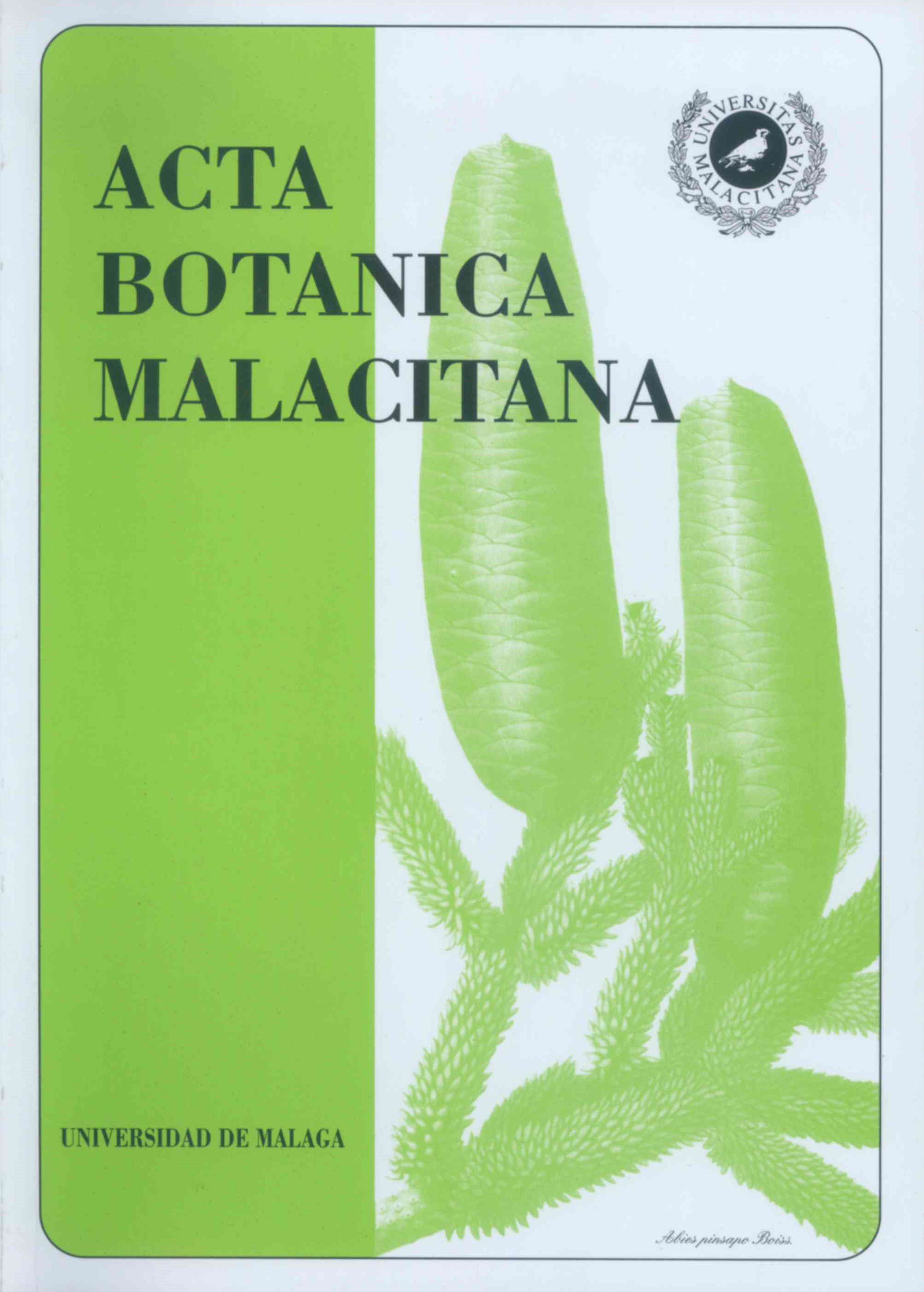Diversidad floral y de estrategia de vida en Teucrium L. (Lamiaceae)
DOI:
https://doi.org/10.24310/abm.v24i0.8518Palabras clave:
Flores, estrategia de vida, diversidad, Teucrium L., LainiaceaeResumen
Las flores de Teucrium L., muestran una gran diversidad en formas, características florales y mecanismos de polinización. Existe una redundancia funcional en las corolas con forma "tubular", con guías para el néctar y polinizaciónnotrotribal de las secciones Chamaedrys (Mill.) Schreb., lsotriodon Boiss., Scordium (Mill.) Rchb. yPolium subsecciones Rotundifolia (Cohen) ex Valdés Berm. & Sánchez Crespo y Pumilum Rivas Mart. Lapolinización nototribal de las corolas con forma "tubular" y mecanismos de cierre del tubo, mediante unpaladar de pelos asociado a una ligera giba, son exclusivos de la sección Teucrium. La polinización esternotribal de las corolas con forma de "cepillo" y tubo cerrado mediante un "mechón" de pelos situadoen la entrada del tubo de la corola (base del lóbulo anterior), son específicas de las especies ginodioécicasde la sección Poliunz (Mill.) Schrcb. subsecciones Polium y Simplicipilosa S. Puech. Las corolas con formade "bandera" y polinización esternotribal se encuentran en las flores resupinadas de las secciones Spinularia (Boiss.) Kästner y Stachyobotrys Boiss. Estas características florales proporcionan un usosistemático seccional y ponen de manifiesto el potencial evolutivo de las corolas tubulares simpétalas. Teucrium tiene cinco diferentes estrategias de vida establecidas. La estrategia de vida dominante estárepresentada por los caméfitos semideciduos de verano y con reproducción sexual, dispersión por el viento y diásporas adaptadas a la semacoría que muestran las secciones Chamaedrys, Isotriodon, y Polium. Claramente menos frecuentes son los nanofanerófitos, arbustos bajos y ramificados, semidecíduos deverano que dispersan por acción del viento, mediante pogonosporas con cálices actinomorfos de lassecciones Teucrium y Teucriopsis Benth., y las hierbas perennes decíduas de invierno con reproducciónasexual y semacoría. En algunos casos, son rizomatosas como en la sección Chamaedrys o estoloníferas como en la sección Scordium Kastner. Finalmente, las hierbas anuales postradas o espinescentes decíduasde invierno o de verano que dispersan mediante balosporas y esclerosporas con cálices zigomórficos, y lashierbas perennes y matas decíduas de invierno o verano, que dispersan por balosporas y tienen cálices bilabiados de la sección Scorodonia (Hill) Schreb., y de T. betonicum L'Hér y T. abutiloides L'Hér de lasección Teucriopsis.
Descargas
Métricas
Citas
ABU-ASAB, M. S. & P. D. CANTINO -1993- Phylogenetic implications of pollen morphology in tribe Ajugeae (Labiatae). Syst. Bot. 18(1): 100-122.
BENTHAN, G. -1832/1836- Labiatarum Genera et Species. Ridgway & Sons, London.
BOUMAN, F. & A. D. J. MEEUSE -1992- Dispersal in Labiatae. In R. M. Harley and T. Reynolds (eds.). Advances in Labiate Science. pp. 193- 202. Royal Botanic Gardens, Kew.
BOISSIER, P.E. -1879- Labiatae. In: Flora Orientalis, 4: 805-822. Geneave, Basileae: Georg.
BRABANT P., P. H. GOUYON, G. LEFORT, G. VALDEIRON & P.VERNET - I 980- Pollination studies in Thymus vulgaris L. (Labiatae). Oecol. Pl. I: 37-45.
CODY, M. L. & H. A. MOONEY -1978- Convergence versus non-convergence in Mediterranean climate ecosystems. Annual Review of Ecology and Systematics 9: 265-321.
DAFNI, A. & C. O'TOOLE -1994- Pollination syndromes in the Mediterranean: generalizations and pecularities. In Plant-Animal Interactions in Mediterranean-Type Ecosystems, M. Arianoutsou & R. H. Groves (eds.). 125-135. 1994.
DANSEREAU, P. & K. LEMS -1957- The grading of dispersal types in plant communities and their ecological significance. Contributions de l'Institute de Botanique de 1 'Université de Montreal 71: 1-52.
EL OUALIDI, J. & S. PUECH -1993- Quelques marqueurs morphologyques des Teucrium section Polium (Lamiaceae) du Maroc: valeur diagnostique a differents niveaux d'integration. Acta Bot. Malacitana 18: 153-162.
FAEGRY, K. & L. VAN DER PIJL -1979- The principes of pollination ecology. Third revised edition. 244 pp. Pergamon Press, Oxford.
GUTTERMAN, Y. -1993- Seed germination in desert plants. Berlin.
HEDGE, I. C. -1992- A global survey of the biogeography of the Labiatae. In R. M. Harley and T. Reynolds (eds.). Advances in Labiate Science. Pp. 7-17. Royal Botanic Gardens, Kew.
HERRERA, J. -1986- Flowering and fruiting phenology in the coastal shrub-lands of Dofiana, South Spain. Vegetatio 68: 91-98.
HERRERA, C. M. -1987- Components of pollinator "quality": comparative analysis of a diverse insect assemblage. Oikos 50: 79-90.
JENNY, M. -1995- Dispersal and micro-habitat conditions within a desert plant community (Wadi Araba, Jordan). Bot. Jahrb. Syst. 116: 483-504.
KAMPNY, C. M. -1995- Pollination and flower Diversity in Scrophulariaceae. The Botanical Review 4(61): 350-366 ,
KUMMEROV, I. -1983- Comparative phenology of Mediterranean-type plant communities. In: Kruger, F. J., Michell, D. T. & Jarvis, J.U.M. (eds.). Mediterranean-type Ecosystems: The role of Nutrients. No. 43, Springer, Berlin, pp. 300- 317.
KASTNER, A. -1989- Übersicht zur systematischen Gliederung der Gattung Teucri um L. Biocosme Mésogéen 6(1-2) 63-78. Nice.
MARIN, P. D., B. PETKOVIC & S. DULETIC - 1994- Nutlet sculpturing of selected Teucrium species (Lamiaceae): a character of taxonomic significance. Pl. Syst. Evol. 192: 199-214.
MEEUSE; A .D.J. -1992- Anthecology of the Labiatae: An armchair approach. In R. M. Harley and T. Reynolds (eds.). Advances in Labiate Science. pp. 183-191. Royal Botanical Gardens, Kew.
NAVARRO, T. -1995- Revisión del género Teucrium L. sección Polium (Mill.) Schreb. (Lamiaceae)en la Peninsula lberica y Baleares. Acta Bol. Malacitana 20: 173-265.
NAVARRO, T. & J. EL OUALID1 -1997- Synopsis of the genus Teucrium L. (Lamiaceae) in Morocco. Acta Bol. Mcdacitana 22: 187-205.
PATON, A. -1992- The adaptative significance of calyx and nutlet morphology in Scutellaria. In
R. M. Harley and T. Reynolds (eds.). Advances in Labiatae Science. pp. 203-210. Royal Botanic Gardens, Kew.
PETANIDOU, TH. -1996- Labiatac: A key family for wild bees and the pollination. Ecology in Mediterranean Phryganic communities. Lamiales Newsletter 4: 4-6.
PUL, VAN DER L. -1972a- Functional consideration and observation an the flowers of some Labiatae. Blumea 20: 93-103.
PUL, VAN DER L. -1972 b- Principles of Dispersal in higher plants. 2" edn., 362p. Springer Verlag, Berlin.
QUEZEL, P. -1985- Definition of the Mediterranean region and the origin of the flora. In: Gomez- Campo, C. (ed.), Plant Conservation in The Mediterranean Area. Dr W. Junk Pubblishers, Dordrecht, pp. 9-43.
RAUNKIAER, C. -1905- Om biologiske Typer, med Hensyn til Planternes Tilpasning til at overleve ugunstige Aarstider. Botanisk Tidsskrift, 26. Kobenhavn.
SHMIDA, A. & A. DAFNI -1989- Blooming strategies, flower size and advertising in the "lily-group" geophytes in Israel. Herbetia 45: 11-123.
SHMIDA, A. & R. DUKAS -1990- Progresive reduction in the mean body size of solitary bees active during the flowering season and its
correlation with the sizes of bee flowers of the mint family (Lamiaceae). Israel Journal of Botany 39: 133-141.
STEBBINS, G. L. -1974- Flowering Plants: Evolution above the species level. 33 Harvard University Press, Cambridge, Mass.
ZOHARY, M. -1937- Die verbreitungsokologischen Verhaltnisse der Planzen Palastinas. Bot. Centralbl., Beih. 56. 1-155.
RYDING, 0. -1998- Teucrium (Lamiaceae) in NE tropical Africa. Notes Roy. Bot. Gard. Edinburgh 55(2): 209-220.
Descargas
Publicado
Cómo citar
Número
Sección
Licencia
Toda la información relacionada con la licencia de uso de los trabajos publicados en Acta Botanica Malacitana y con los derechos de autor se pueden consultar en nuestra Política Editorial.







1.png)


